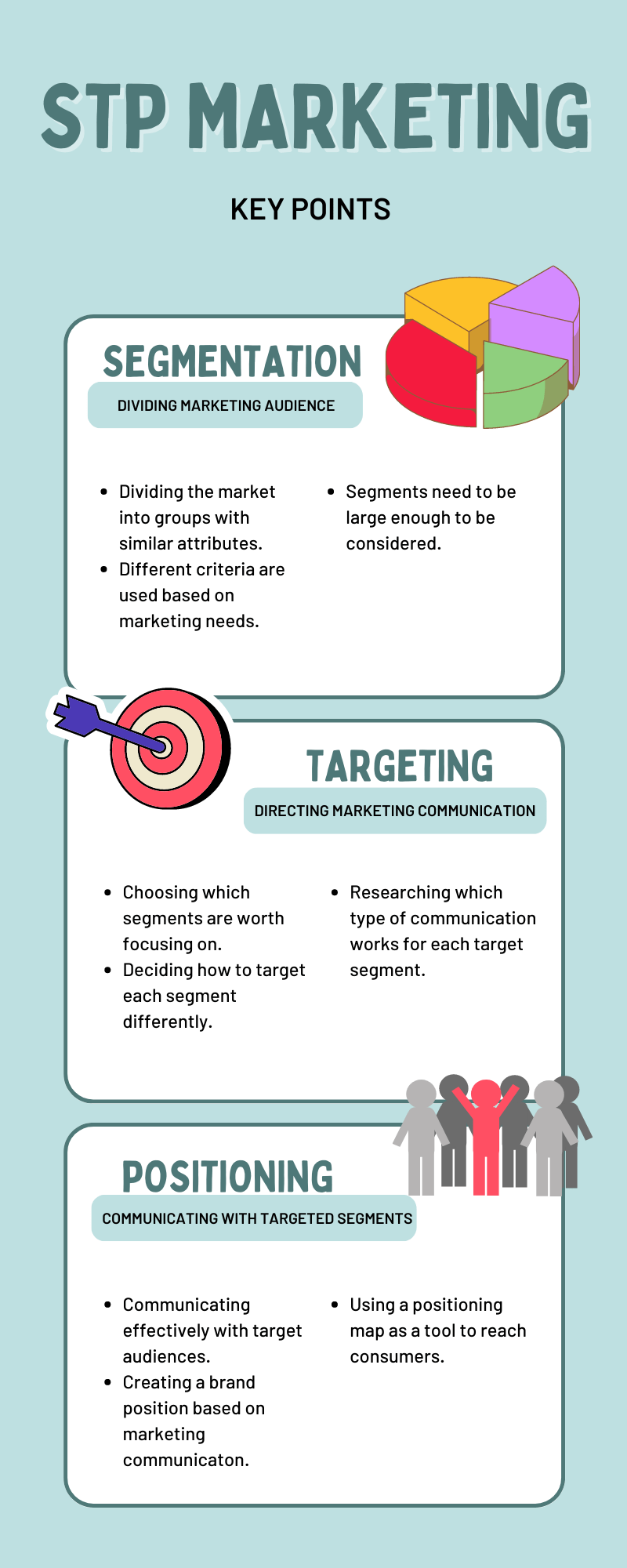You’re bound to come across STP in marketing once you get serious about honing your skills in this field. Regardless of the size of your business endeavor, you can achieve better results by developing an STP marketing strategy.
In this article, we’ll explain everything you need to know about STP strategy, how to develop the strategy, and the advantages you will get by doing so.
What Is STP in Marketing?
The STP approach is a method used by marketing professionals to improve marketing communications. Essentially, this strategy redefines two things:
- Who you should market your products to
- How you market your products.
Although it sounds very technical, STP reduces your marketing strategy to three stages we’ve seen applied in marketing plans of all different sizes. You can use this strategy as a planning tool to help you in the beginning stages of your marketing, or later on if you need to rethink your approach.
In any case, STP marketing is a three-part strategy: segmentation, targeting, and finally positioning. We’ll get into further details on each part below:
Segmentation
The first stage of this process is where a business should identify who its marketing audience is. Many businesses in the past have tailored generic marketing communication which is a “one-size-fits-all”. However, this usually proves that broad messages fall flat and do not resonate with a large portion of the audience.
Instead, the audience is segmented into groups based on criteria that suit the mission, vision, and goals of the business. Groups are generally categorized as demographic, geographical, psychographic, and behavioral.
While those terms seem complicated, you can simplify the process if you think about it in basic terms. Here are some basic criteria that are traditionally used in segmentation.
- Age
- Gender
- Social status
- Purchase history
- Interests
Nowadays, with the advent of social media and AI-powered programming, it’s possible to create even more specialized segments based on your audience’s preferences and more specific details. Remember that the marketing messages sent to each segment should be different.
Targeting
The “T” in STP stands for targeting. It is the stage in this strategy whereby you can choose which segments are worth focusing your communication on. It is also about the methods you can use to direct your marketing communication toward the intended audience.
For example: Let’s say a realtor has divided their customer base into segments based on social status. If the realtor has a database mostly consisting of luxury properties, their marketing should be targeted towards upper-class clientele instead of those looking for more affordable homes.
Also, the focus of marketing messages would be the high-quality materials and elegant interior design—not lower lease rates. In other words, marketers use targeting to research which are the best methods to engage with specific segments of the market.


Positioning
The last stage of this process is to use the information collected during segmentation and targeting to communicate and position a product or brand in the market. This means changing consumers’ perception of your product, especially when related to other products in the market.
You can use a Product Positioning Map to decide how to navigate this phase of the STP marketing approach. This tool will help you find untapped markets that you could engage with and sell more products that way. We’ll describe how to use a positioning map in the next section.
How to Develop STP Marketing Strategy
Developing your STP marketing strategy is not as complicated as it sounds. By focusing on the basics, anyone can apply STP to their marketing.
The infographic below will summarize the key points involved in the STP process. For a more detailed description, keep reading.


Here’s a step-by-step rundown of the STP marketing process.
- Choosing criteria for segmentation: After gathering consumer data and performing marketing research, you should be able to ascertain what characterizes your consumers and what factors you use to differentiate between them. Also, consider buying behavior and segmentation criteria of your competitors.
- Selecting segments to target: Next, think of your ideal consumer and which market segments they fall into. You should then consider which segments to focus your branding communication on.
- Researching effective targeted communication: Once you have determined who will receive your targeted marketing, you should establish how. Rely on research to find the most effective ways to communicate with your target audience and the ideal times to do so. Analyze how different segments of your target market respond to various marketing methods.
- Position mapping: Plot two or more characteristics of your competitors’ products on a map, and position each product accordingly. For example, one brand may be healthy and tasty but not affordable. Another product may be tasty and affordable but unhealthy. Keep mapping products until you find where you would like to position yours.
- Positioning through marketing communication: Once you’ve determined what attributes you want to be associated with your product, it’s time to communicate that with your target audience. Think of what type of communication you can use to change consumer perception of your product. Which is the most effective and efficient method to achieve those results?
Advantages of the STP Approach
Although STP marketing has been around for a while, there are still some marketers and entrepreneurs that are unfamiliar or otherwise hesitant to apply it. Yet, there are several advantages to consider before you make that decision:
- More focused communication with your target consumer.
- It is an efficient marketing method.
- STP marketing enables brands to find untapped markets, or gaps in the market that are worth pursuing.
- More cost-efficient than other marketing methods.
- Increased sales due to efficient targeting and precise segmentation.
- Improving customer relationships through better engagement.
- More feedback from the right consumers allow for further development of the product line.
These are merely the basic benefits of the STP marketing strategy, which is why the approach has become very popular. Regardless of the size of your business or the type of product, you are trying to market, consider using this approach to improve your marketing results.
Key Takeaways
STP is used in marketing to help choose the right target market and define the methods to communicate with them. By first dividing the masses into segments, marketers can customize marketing messages and position products more effectively because all potential consumers are engaged accordingly. The overall process is highly efficient and cost-effective, making it a sound business decision to include STP in any modern marketing plan.





















Leave a Reply
View Comments